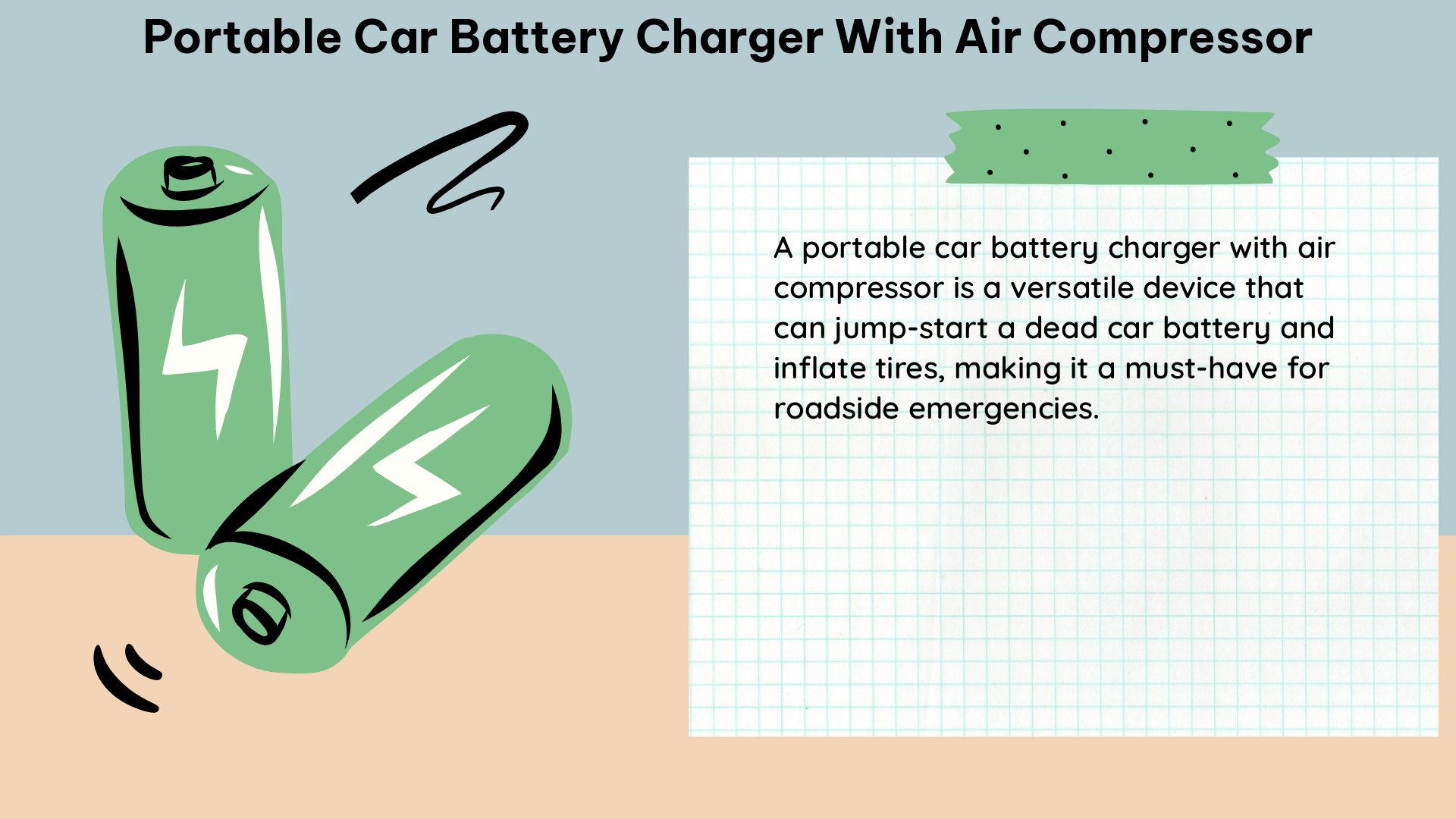A portable car battery charger with an air compressor is a versatile tool that can jump-start your vehicle and inflate your tires, making it an essential accessory for any car owner. These devices typically have technical specifications that include peak output current, output voltage, and dimensions, providing a range of features to meet your needs.
Technical Specifications
When selecting a portable car battery charger with an air compressor, it’s crucial to consider the device’s technical specifications. Here are some key factors to keep in mind:
Peak Output Current
The peak output current, measured in amperes (A), determines the maximum amount of current the device can deliver to jump-start your car’s battery. A higher peak output current means the device can handle larger batteries more effectively. For example, the Schumacher Electric 12V Portable Power with Air Compressor has a peak output current of 1000A.
Output Voltage
The output voltage, measured in volts (V), is the voltage the device provides to charge or jump-start your car’s battery. Most portable car battery chargers with air compressors operate at 12VDC, which is the standard voltage for most passenger vehicles.
Dimensions and Weight
The dimensions and weight of the device are important considerations, as you’ll need to store it in your vehicle. The Schumacher Electric 12V Portable Power with Air Compressor measures 13.75″ (width) x 10.75″ (depth) x 11.75″ (height) and weighs 12.86 lb.
Built-in Charger
Many portable car battery chargers with air compressors, like the Schumacher Electric model, include a built-in charger for the internal battery. This feature allows you to keep the device charged and ready for use.
Energy Efficiency
Look for devices that meet industry standards for energy efficiency, ensuring they operate safely and effectively.
Factors to Consider

When selecting a portable car battery charger with an air compressor, there are several factors to consider beyond the technical specifications:
Operating Temperature
The device’s operating temperature range is crucial, as storing it in a car trunk or glovebox when outside temperatures might occasionally peak at around 105°F can reduce its lifetime and potentially pose a fire risk. It’s recommended to store these devices in the trunk, as low down as possible and covered up, to minimize the impact of high temperatures.
Lead Length
The length of the cables or leads that connect the device to your car’s battery can be an important factor, as longer leads provide more flexibility in positioning the charger.
Battery Type
Lithium-ion batteries are a popular choice for portable car battery chargers with air compressors, but cheap lithium packs may have a shorter lifespan of around a year. Lead-acid batteries, on the other hand, can have their batteries replaced when they no longer work, potentially extending the device’s usable life.
Cost
As mentioned, it’s crucial to spend at least $150 to get a decent portable car battery charger with an air compressor, as most combo units are of poor quality.
Proper Storage and Maintenance
To ensure the longevity and safety of your portable car battery charger with an air compressor, it’s essential to store and maintain the device properly:
- Store the device in the car trunk, as low down as possible and covered up, to minimize the impact of high temperatures.
- Avoid leaving the device in direct sunlight or exposed to extreme temperatures for extended periods.
- Keep the device clean and free of debris, and follow the manufacturer’s instructions for maintenance and storage.
- Regularly check the device’s internal battery and replace it if necessary, especially for lead-acid models.
By considering the technical specifications, operating factors, and proper storage and maintenance, you can ensure that your portable car battery charger with an air compressor provides reliable and safe performance for years to come.
References:
- Personal Recommendations for Both Portable Jump Starter and Air Compressor
- Portable Car Battery Charger with Air Compressor Review
- Schumacher Electric 12V Portable Power with Air Compressor
- Portable Car Battery Starter with Air Compressor
- Dangerous to Store Jump Starter Power Bank in Car When Outside Temperatures Peak

The lambdageeks.com Core SME Team is a group of experienced subject matter experts from diverse scientific and technical fields including Physics, Chemistry, Technology,Electronics & Electrical Engineering, Automotive, Mechanical Engineering. Our team collaborates to create high-quality, well-researched articles on a wide range of science and technology topics for the lambdageeks.com website.
All Our Senior SME are having more than 7 Years of experience in the respective fields . They are either Working Industry Professionals or assocaited With different Universities. Refer Our Authors Page to get to know About our Core SMEs.